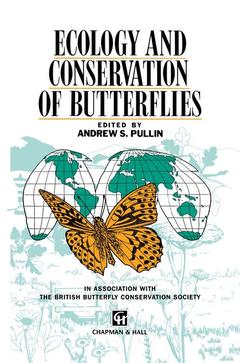Description
Ecology and Conservation of Butterflies, 1995
Coordinator: Pullin A.S.
Language: English
Subjects for Ecology and Conservation of Butterflies:
Keywords
Lepidoptera; biodiversity; conservation; distribution; ecology; population; structure; Entomology
Publication date: 10-2012
363 p. · 15.5x23.5 cm · Paperback
363 p. · 15.5x23.5 cm · Paperback
Description
/li>Contents
/li>Comment
/li>
This book was conceived to mark the Silver Jubilee of the British Butterfly Conservation Society. Interest in the conservation of butterflies has increased so rapidly that it is difficult to relate to the situation 25 years ago. Butterflies were on the decline in Britain, Europe and elsewhere but we lacked data on the extent of the decline and the underlying reasons, leaving us unable to implement effective conservation measures. An early recognition of the plight of British butterflies and moths led to the foundation of the society by a small group of conservationists in 1968. Today the society has over 10000 members, owns a number of reserves and sponsors research, conservation and monitoring activities at the local and national level. As part of the Silver Jubilee celebrations an international symposium was held at Keele University in September 1993 entitled 'Ecology and Conservation of Butterflies'. This symposium clearly showed how much important work has been done in recent years and also gave me the impression that the subject had reached a watershed. This was not because the decline of butterflies has stopped or even slowed down, far from it, the threat to our butterflies continues to increase from habitat destruction and intensification of land use. The watershed is in our understanding of the relationship between butterflies and their habitat.
One Monitoring Distribution and Abundance.- 1 Butterfly monitoring 1 — recording the changes.- 2 Butterfly monitoring 2 — interpreting the changes.- 3 Butterfly mobility.- 4 Ecology and conservation of butterfly meta-populations in the fragmented British landscape.- Two Butterflies and Land Use in Britain.- 5 Butterflies on nature reserves in Britain.- 6 Butterfly conservation on arable farmland.- 7 Butterfly conservation within the management of grassland habitats.- 8 Woodland management and butterfly diversity.- 9 Gardens: the neglected habitat.- Three Managing Endangered Species.- 10 The ecology and conservation of Papilio machaon in Britain.- 11 Ecology and conservation of Lycaena dispar: British and European perspectives.- 12 The conservation of Carterocephalus palaemon in Scotland.- 13 The ecology and conservation of Maculinea arion and other European species of large blue butterfly.- 14 Managing local microclimates for the high brown fritillary, Argynnis adippe.- Four European and Global Perspectives.- 15 Implications of biogeographical structures for the conservation of European butterflies.- 16 Measuring changes in butterfly abundance in The Netherlands.- 17 Conservation of butterflies in central Europe.- 18 Ecology and conservation of alpine Lepidoptera.- 19 Conservation of butterfly habitats and diversity in European Mediterranean countries.- 20 Butterfly biodiversity and conservation in the Afrotropical region.- 21 Butterfly conservation in Australasia — an emerging awareness and an increasing need.- 22 Conservation and management of butterfly diversity in North America.- References.- Butterfly species index.
...a blockbuster of a book, packed with information and more than 650 references...Make sure you have access to this book if you are involved in any conservation work. - BBC Wildlife, Anyone concerned with nature conservation (regardless of which group they are fond) should study this book.European Journal of Entomology, Scientists, nature conservationists and amateur entomologists, as well as environmentalists, will find this book of considerable value in gaining access to up-to-date information to conservation endeavours...a well thought out compilation. - Int J of Environmental Statics, ...an excellent book, one which should be compulsory reading for all those interested in conservation in general and in the conservation of butterflies in particular. - Biodiversity and Conservation
© 2024 LAVOISIER S.A.S.




